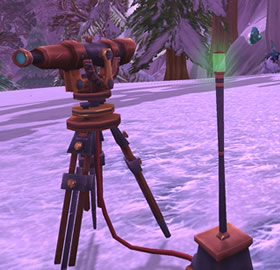Archaeology for Pet Collectors
WoW Archaeology offers a variety of companions to vanity pet collectors. There are many pets available to burgeoning archaeologists. No doubt more will become available in future patches and expansions, making this a must-have secondary skill for any serious pet collector.
Contents
How Archaeology Works
The way WoW Archaeology works is there are four dig sites available to you at any one time on each of the continents (Eastern Kingdoms, Kalimdor, Outland, Northrend, Pandaria, and Draenor).
Archaeology in WoW works basically by triangulation. If you aren't familiar with the term, triangulation is the process of determining the location of a point by measuring angles to it from known points at either end of a fixed baseline, rather than measuring distances to the point directly. The point can then be fixed as the third point of a triangle with one known side and two known angles. Yeah, that's too technical for me too.
Anyhow, once you pick up Archaeology as a secondary tradeskill, you learn two new skills available in your spellbook: Archaeology and Survey.
Archaeology is used to put the fragments you find together into new items (like pets), and Survey is what you use to find the fragments.
Getting Started with WoW Archaeology
Okay, you've purchased the Archaeology tradeskill from a trainer (located in any capital city) and have begun the fun grind to get the archaeological companion pets.
Once you have it learned, head out to Draenor and start any digsite that is close to you. You don’t have to level it in Draenor forever, this is just so you get a Brittle Cartography Journal, which allows Archaeology training up to max level. This means you won’t need to visit a trainer ever again. Yay!

The biggest changes to Archaeology now is all dig sites before Draenor have six nodes available. Draenor digsites have nine. You also continue leveling up to skill level 700 just from digging and collecting fragments. Previously you could only level by combining fragments after the first tier, which ended at 75.
If you want to focus on only one continent for leveling, you can choose Kalimdor, Eastern Kingdoms and Draenor from 1 to 700.
The best reason to choose Draenor, even before flying is available, is any artifact you craft can be crated and turned in to Brann Bronzebeard (A and H), Grakis (A), or Srikka (H) for fragments of your choice from any other archaeology type. You can’t trade them in until you have Archaeology skill level 600, but it’s easy to collect them and it doesn’t take up much room. Any solves before Pandaria becomes an item that can be vendored and takes up inventory space.
Creating WoW Archaeology Items via Fragments
Now we get into the actual Archaeology button. When you start out, you'll notice 10 buttons available, but only four will be lit up until 300. Those buttons are used to combine the more common fragment types:
- Dwarf
- Fossil
- Night Elf
- Troll
Night Elf and Fossil come mostly from Kalimdor, and Dwarf and Troll come from Eastern Kingdoms (although Fossil fragments can be found in Eastern Kingdoms too).
It takes roughly 30+ fragments to create an item. Items which are uncommon require 30-35 fragments of a given type. Semi-rare items take 85-100 fragments, such as the Fossilized Hatchling, and rare items require 100+.
Collecting Archaeology Companions
You want the pets. That’s why you’re reading this guide. Here are the types you need to focus on to get all the pets as well as the skill level required to work towards them:
- Arakkoa (Draenor) – Ancient Nest Guardian (1)requires 200 Fossil fragments
- Dwarf (Eastern Kingdoms) – Clockwork Gnome (1)requires 100 Fossil fragments
- Tol’vir (Uldum) – Crawling Claw (450)requires 150 Fossil fragments
- Fossil (Eastern Kingdoms and Kalimdor) – Fossilized Hatchling (1)requires 85 Fossil fragments
- Fossil (Eastern Kingdoms and Kalimdor) – Pterrordax Hatchling (1)requires 120 Fossil fragments
- Draenor Clans (Draenor) – Frostwolf Ghostpup (1)requires 175 Fossil fragments
- Troll (Eastern Kingdoms and Kalimdor) – Voodoo Figurine (1) requires 100 Troll fragments





